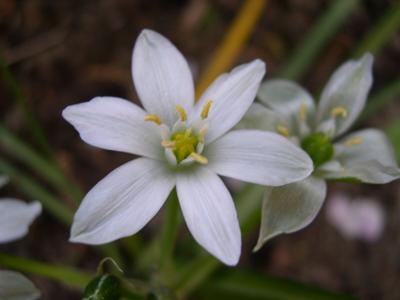
See if you can correctly guess this week’s mystery plant. [Answer: “Milk-star,” Ornithogalum umbellatum]
Watch out for the weeds, both the annuals and the perennials! Even in Shakespeare’s time, as now, gardeners had to be vigilant, getting rid of the interlopers as soon as they appeared. Of course, they didn’t have fancy, expensive herbicides to spray all over the place. (Maybe that’s the way it should be now.)
Now here is a spring weed — a perennial — that is popping up, and it’s a wonderful little thing. It’s an old-timey bulb plant for the garden, but is not often cultivated these days. When they suddenly appear in lawns, most people want to get rid of them. They do tend to spread themselves around, especially by divisions of their little bulbs. The plants don’t get but about a foot tall with a shock of narrow, deep green, odorless leaves. The stem will bear up to a dozen or more milk-white flowers, each one on a long stalk, and very star-like. These flowers don’t open until about noon, and then they tend to get “sleepy” at dusk, and will be closed all night long, opening up again the next day. There will be three sepals and three petals, each of them with a prominent green stripe on the back. Six stamens are inside, their filaments broad and flattened at the base, and tipped at the end with a yellow anther. The ovary down below is bright green, eventually forming an angled seed pod. The flowers look like they would be fragrant...but, no.
This plant is distantly related to lilies, and is probably more closely related to what we know as hyacinths. It is native to southern Europe and northern Africa, and has been grown for a long time in Europe and America in gardens. It is commonly naturalized east of the Mississippi River, and scattered elsewhere in North America, often showing up in vacant lots and meadows. As charming as this plant is in the garden, it does have a rather poisonous side. All the parts are a bit toxic, especially the bulbs, and it should never be eaten.
The scientific name alludes to the flowers, and the genus name, taken from Greek, actually translates as “bird’s milk”…a name you won’t see in the garden centers. This curious name comes from an ancient notion that white doves were able to produce milk, and so feed their young ones. The flowers of our Mystery Plant are as white as doves, so there we are; it’s a bit of a stretch. (If you do know this plant, you may have heard it called “Star of Bethlehem,” a name that has also been used for a completely different spring-bloomer, Tristagma uniflora, which is also blooming now, but which has bluish-purple flowers, and very oniony-smelling leaves.)
©JohnNelson2024.
John Nelson is the curator of the A. C. Moore Herbarium at the University of South Carolina, in the Department of Biological Sciences, Columbia SC 29208.
As a public service, the Herbarium offers free plant identifications. For more information, visit www.herbarium.org or call (803) 777-8196, or email nelson@sc.edu.






